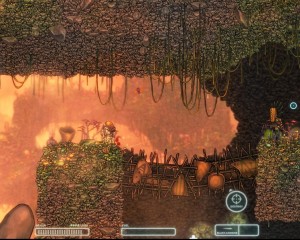Anomaly: Final Thoughts
I said before that I wasn’t sure whether it’s better to say that the player character in Anomaly: Warzone Earth protects the convoy or vice versa. Well, now that I’ve been knocked around a bit more, I can say that it’s definitely the former. The PC doesn’t really need protection; he’s literally tougher than a tank. Most of the enemy turret types can’t even really hurt him by themselves, because he heals so fast. Even when multiple ones acting in concert do manage to knock him down to zero, it only lasts a few seconds. It’s all due to his “battle suit”, apparently, which effectively makes him a superhero.
Still, you need to stick with your convoy most of the time for their sake when you send them into the thick of things. Even tanks protected by force field generators need protection that only a battle-suited superhero can provide. And so the designers quite sensibly come up with ways to force you away from them.
There’s a type of tower that fires missiles that, on hitting their target, create a sort of jamming signal that makes you look like an enemy to your own troops unless you stay outside its range. This is a problem not for the danger it poses you, but because it makes your guys aim at the wrong thing. A tower of this sort can prevent you from lending crucial aid in a pitched battle. I’ve found that the best way to deal with this is by calling in an air strike on the tower before it’s an issue, but it took me a while to realize that this was an option, because getting close enough to the thing to do so usually requires dashing through enemy defenses alone.
Later, there’s another tower type that can’t be approached this way: if you get near it, and within a line of sight, it fires a continuous beam that absorbs energy from your battle suit. It then uses this energy to heal itself and to power up its special ability to re-create towers you’ve destroyed. Letting it use that spell even once can mean defeat, so you don’t want to get near it. The curious thing about both of these area-denial towers is that they’re not capable of damaging your convoy by themselves. They’re purely support units, and they provide support of sorts that I don’t recall seeing used in normal tower defense games — mainly because they both involve warding off a player character.
At the end of each level, the game evaluates the player’s performance on three axes: directness, ruthlessness, and efficiency. Directness has to do with how fast a route you took, ruthlessness is based on how much stuff you killed, and efficiency seems to be all about how many smokescreens and air strikes and so forth you have left at the end. Directness and ruthlessness are almost opposites: if you’re destroying everything on the map, you’re necessarily doubling back on your path a lot. At the game’s beginning, when I was just learning the mechanics and didn’t have force fields yet, I got high directness bonuses, but by the end, I was flat-out ruthless. That’s because ruthlessness is the cautious approach. Caution means minimizing the number of towers you engage at a time, and that means looping around the more sparsely-defended blocks until you can advance to the next block without being hit from behind.
In fact, by the end, my tactics were pretty procedural and by-the-numbers, upset only slightly by an end boss capable of respawning nearby towers endlessly. This is the sort of thing that leaves me wondering if the game has exhausted the potential of its mechanics, if it leaves no room for expansion or imitation. But then, those two special towers I described aren’t exactly elementary types that anyone making a similar game would invent, and that hints at more elaborate possibilities.
 Comments(0)
Comments(0)